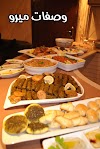Food safety when cooking
غير معرف
سبتمبر 06, 2011
The way we cook our food is as important as the way we prepare and store it. Inadequate cooking is a common cause of food poisoning. Most foods, especially meat, poultry and eggs, should be cooked thoroughly to kill most food poisoning bacteria.
In general, food should be cooked to a temperature of at least 75°C or hotter. When food is cooked, it should be eaten promptly, kept hotter than 60°C, or cooled, covered and stored in the fridge or freezer.
Some people are more at risk from food poisoning than others. Vulnerable groups include pregnant women, young children, the elderly and anyone with an illness. Special care should be taken when preparing, cooking, serving and storing food for these groups.
High-risk foods
Food poisoning bacteria grows more easily on some foods than others. These high-risk foods include:
* Meat
* Poultry such as chicken and turkey
* Dairy products
* Eggs
* Smallgoods such as salami
* Seafood
* Cooked rice
* Cooked pasta
* Prepared salads such as coleslaw, pasta salads and rice salads
* Prepared fruit salads.
High risk foods and the temperature danger zone
Take care with high risk foods. You should:
* Keep high risk cooked foods out of the ‘temperature danger zone’ of between 5°C and 60°C.
* Throw out any high risk cooked food left in the temperature danger zone for more than four hours.
* Don’t keep or store any high risk cooked food left in the temperature danger zone for more than two hours. Don’t leave it for later and don’t store it in the fridge.
Cook all food to a temperature of 75°C
How you cook food is very important. Different foods need a different approach:
* Aim for an internal temperature of 75°C or hotter when you cook food. Heating foods to at least this temperature kills most food poisoning bacteria. If you have a meat thermometer, check the internal temperature of meat during the cooking process.
* Cook mince, sausages, whole chickens or stuffed meats right through to the centre. You should not be able to see any pink meat and the juices should be clear.
* Cook steak, chops and whole roasts to your preference as food poisoning bacteria are mostly on the surface.
* Cook white fish until it flakes easily with a fork.
* Cook foods made from eggs such as omelettes and baked egg custards thoroughly.
Foods with raw eggs:
Take extra care when preparing foods that use raw egg, such as eggnog and homemade mayonnaise. Bacteria on the eggshells can contaminate food and cause food poisoning.
Avoid giving food made with raw eggs to pregnant women, young children, elderly people and anyone with an illness.
Microwave cooking:
Microwaves are a quick and convenient way to cook food. However, if they are not used correctly, they can cook food unevenly. This may leave food partially cooked or not reaching a temperature of 75°C. When you cook food in the microwave:
* Cut food into evenly sized pieces if possible, or put larger or thicker items towards the outside edge of the dish.
* Cover the food with a microwave safe lid or microwave plastic wrap. This will trap the steam and promote more even cooking.
* Rotate and stir food during cooking.
* Wait until the standing time is over before you check that the cooking is complete. Food continues to cook even after the microwave is turned off.
Cooling and storing:
If you need to store food for later use, wait until the steam stops rising, cover the food and put it in the fridge. This helps keep the food out of the temperature danger zone as fast as possible. Large portions of food cool faster when you put them into shallow trays or divide them into smaller pieces.
If you need to keep food warm, keep it hotter than 60°C and out of the temperature danger zone.
Under ideal conditions, cooked food can be stored in the fridge for a few days. If you want to keep cooked food longer, freeze the food immediately after cooling in the fridge.
Always store cooked food separately from raw food, especially raw meats, poultry and fish. Keep raw meats and poultry at the bottom of the fridge to avoid raw juices dripping onto other food. Ensure that all food is covered or sealed.
Reheat food to steaming hot:
Reheat food until it is steaming hot – above 75°C or, preferably, boiling. Food should steam throughout, not just on the edges. Take care when reheating food in a microwave oven. Follow the same actions as when cooking with a microwave to ensure all the food is heated to steaming hot.
Things to remember
* Cook food properly – to at least 75°C or hotter.
* If you use a microwave, check that the food is cooked evenly throughout.
* Cool and store cooked food as soon as possible.
* Reheat food to steaming hot.
بحث هذه المدونة الإلكترونية
مواضيع عشوائية
3/random/post-list
كل يوم معلومه جديده
ضيفي للعجينة معلقة خل وهتلاحظي الفرق
عشان الكيكة تطلع هشه وجميلة
الأكثر بحثاً

طريقه تحضير طاجين الزيتون
أغسطس 06, 2012

بديل صوص الباربكيو
يونيو 17, 2011

بديل محسن الكيك أو الخبز
يونيو 17, 2011

طاجين الدجاج المشرمل
أغسطس 06, 2012

صوص التارتار
أكتوبر 29, 2020

بديل الجبنة الماسكربونى
يونيو 17, 2011
التسميات
- آيس كريم وفواكه
- أطباق الأرز بأنواعه
- أطباق الأسماك وثمار البحر
- أطباق الخضار
- أطباق الدجاج والطيور
- أطباق اللحوم والمشويات
- أطباق المحاشي
- أطباق المكرونة والباستا
- أطباق رئيسية
- أطباق نباتيه
- أفكار سهلة لزينة رمضان
- أكلات الأطفال
- اكلات صيامى
- السلطات
- الشوربات
- المعجنات والمخبوزات
- المقبلات الشهية
- انـواع مـن المربي
- تعرفي على مقاييس الطعام والسعرات الحراريه
- تمارين رياضية
- حيل وأفكار ذكية
- دليلك الطبى
- فيديوهات
- كوكيز وبسكويت
- ملف البقع والتنظيف وتنظيم البيت
- ملف شامل لطرق عمل الكيكة الاسفنجية
- ملف شامل لطرق عمل تشيز كيك
- ملف كامل لجميع طرق الكب كيك
- وجبات خفيفة وساندوتشات
- وصفات الديك الرومي
- وصفات لمرضى السكري
- وصفات من حول العالم
أشهر مقالات وصفات ميرو

تزيين الكيكات بعجينة السكر
يناير 13, 2013

قائمه لافطار عزومه رمضان
يوليو 09, 2013

ميني بسبوسة تشيز كيك
مارس 09, 2013

بديل الجبنة الماسكربونى
يونيو 17, 2011

فانوس رمضان من الورق الملون للتزيين
يوليو 09, 2013
لو عندك سؤال أبعتيلنا
Menu Footer Widget
Crafted with by MeRo Recipes






0 تعليقات